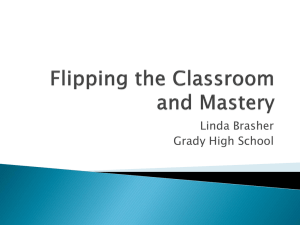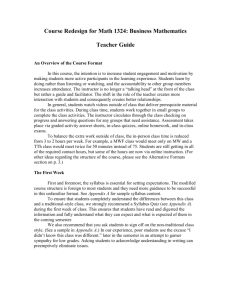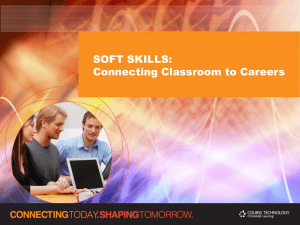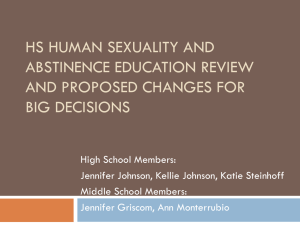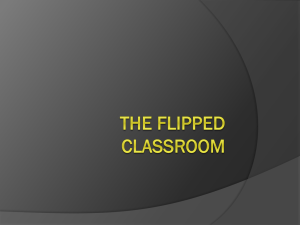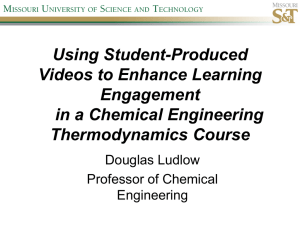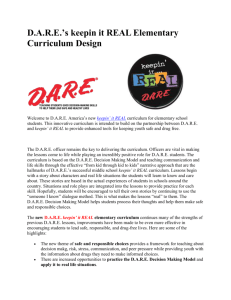Student derived experimental procedures in a flipped lab
advertisement
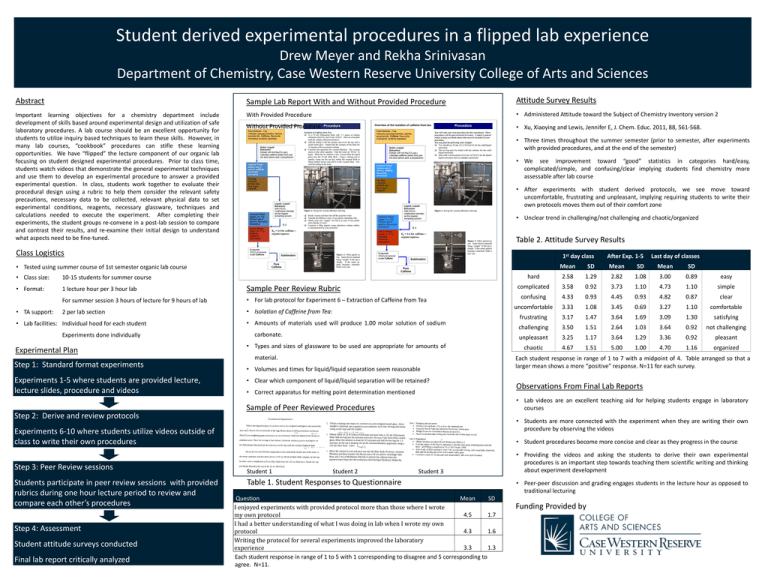
Student derived experimental procedures in a flipped lab experience Drew Meyer and Rekha Srinivasan Department of Chemistry, Case Western Reserve University College of Arts and Sciences Abstract Sample Lab Report With and Without Provided Procedure Attitude Survey Results Important learning objectives for a chemistry department include development of skills based around experimental design and utilization of safe laboratory procedures. A lab course should be an excellent opportunity for students to utilize inquiry based techniques to learn these skills. However, in many lab courses, “cookbook” procedures can stifle these learning opportunities. We have “flipped” the lecture component of our organic lab focusing on student designed experimental procedures. Prior to class time, students watch videos that demonstrate the general experimental techniques and use them to develop an experimental procedure to answer a provided experimental question. In class, students work together to evaluate their procedural design using a rubric to help them consider the relevant safety precautions, necessary data to be collected, relevant physical data to set experimental conditions, reagents, necessary glassware, techniques and calculations needed to execute the experiment. After completing their experiments, the student groups re-convene in a post-lab session to compare and contrast their results, and re-examine their initial design to understand what aspects need to be fine-tuned. With Provided Procedure • Administered Attitude toward the Subject of Chemistry Inventory version 2 Without Provided Procedure • Xu, Xiaoying and Lewis, Jennifer E, J. Chem. Educ. 2011, 88, 561-568. • Three times throughout the summer semester (prior to semester, after experiments with provided procedures, and at the end of the semester) • We see improvement toward “good” statistics in categories hard/easy, complicated/simple, and confusing/clear implying students find chemistry more assessable after lab course • After experiments with student derived protocols, we see move toward uncomfortable, frustrating and unpleasant, implying requiring students to write their own protocols moves them out of their comfort zone • Unclear trend in challenging/not challenging and chaotic/organized Table 2. Attitude Survey Results Class Logistics 1st day class • Tested using summer course of 1st semester organic lab course • Class size: 10-15 students for summer course • Format: 1 lecture hour per 3 hour lab Sample Peer Review Rubric For summer session 3 hours of lecture for 9 hours of lab • For lab protocol for Experiment 6 – Extraction of Caffeine from Tea • TA support: 2 per lab section • Lab facilities: Individual hood for each student Experiments done individually Experimental Plan Step 1: Standard format experiments Experiments 1-5 where students are provided lecture, lecture slides, procedure and videos Step 2: Derive and review protocols • Isolation of Caffeine from Tea: • Amounts of materials used will produce 1.00 molar solution of sodium carbonate. • Types and sizes of glassware to be used are appropriate for amounts of material. • Volumes and times for liquid/liquid separation seem reasonable • Clear which component of liquid/liquid separation will be retained? • Correct apparatus for melting point determination mentioned Students participate in peer review sessions with provided rubrics during one hour lecture period to review and compare each other’s procedures Step 4: Assessment Student attitude surveys conducted Final lab report critically analyzed Last day of classes Mean SD Mean SD Mean SD hard 2.58 1.29 2.82 1.08 3.00 0.89 easy complicated 3.58 0.92 3.73 1.10 4.73 1.10 simple confusing 4.33 0.93 4.45 0.93 4.82 0.87 clear uncomfortable 3.33 1.08 3.45 0.69 3.27 1.10 comfortable frustrating 3.17 1.47 3.64 1.69 3.09 1.30 satisfying challenging 3.50 1.51 2.64 1.03 3.64 0.92 not challenging unpleasant 3.25 1.17 3.64 1.29 3.36 0.92 pleasant chaotic 4.67 1.51 5.00 1.00 4.70 1.16 organized Each student response in range of 1 to 7 with a midpoint of 4. Table arranged so that a larger mean shows a more “positive” response. N=11 for each survey. Observations From Final Lab Reports • Lab videos are an excellent teaching aid for helping students engage in laboratory courses Sample of Peer Reviewed Procedures • Students are more connected with the experiment when they are writing their own procedure by observing the videos Experiments 6-10 where students utilize videos outside of class to write their own procedures Step 3: Peer Review sessions After Exp. 1-5 • Student procedures become more concise and clear as they progress in the course Student 1 Student 2 Student 3 Table 1. Student Responses to Questionnaire Question Mean SD I enjoyed experiments with provided protocol more than those where I wrote 4.5 1.7 my own protocol I had a better understanding of what I was doing in lab when I wrote my own 4.3 1.6 protocol Writing the protocol for several experiments improved the laboratory 3.3 1.3 experience Each student response in range of 1 to 5 with 1 corresponding to disagree and 5 corresponding to agree. N=11. • Providing the videos and asking the students to derive their own experimental procedures is an important step towards teaching them scientific writing and thinking about experiment development • Peer-peer discussion and grading engages students in the lecture hour as opposed to traditional lecturing Funding Provided by


